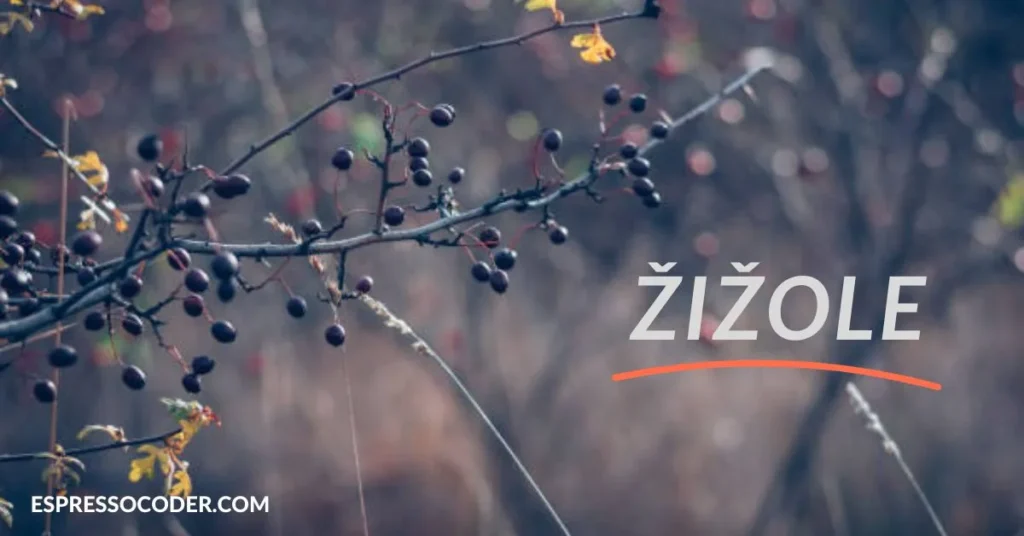Contents
Quick answer
Žižole (Ziziphus zizyphus), also called Chinese dates, are hardy, drought-resistant fruits known for their high vitamin C content and sweet taste. Native to China, these trees thrive even in cold climates and produce edible fruits eaten fresh, dried, or soaked in grape spirits.
Žižole: The Complete Guide to the Hardy and Nutritious Chinese Date
Žižole, or jujube, might not be as widely known in Europe as apples or oranges, but this rugged fruit is making its way into gardens and kitchens thanks to its sweet taste and superfood qualities. Native to China but increasingly popular in the Mediterranean and Central Europe, žižole is a resilient tree with a unique combination of medicinal, nutritional, and culinary benefits.
In this guide, we explore everything about žižole—its history, cultivation, health advantages, and how you can enjoy its fruit throughout the year.
Hook: Whether you’re a home gardener or a health-conscious foodie, žižole deserves a spot on your radar.
Also have a look on:https://espressocoder.com/red-lobster-tgi-fridays-closing/
Key Facts About Žižole
| Feature | Details |
|---|---|
| Scientific Name | Ziziphus zizyphus (or Ziziphus jujuba) |
| Common Names | Žižole, jujube, Chinese date |
| Origin | Northern China |
| Height | Up to 10 meters |
| Climate Tolerance | Down to −25 °C, drought-resistant |
| Blooming Period | May to August |
| Harvest Time | September to October |
| Nutritional Value | ~70 mg vitamin C per 100 g |
| Culinary Uses | Fresh, dried, or soaked in grape marc |
| Taste Profile | Sweet, chewy when dried |
What Is Žižole?
Žižole is a deciduous shrub or small tree that belongs to the buckthorn family. Known for its hardy nature, it has been cultivated in China for over 4,000 years and has spread to the Middle East, Mediterranean, and even parts of the United States.
Botanical Overview
- Grows up to 10 meters tall
- Curved branches with sickle-shaped thorns
- Leathery, serrated leaves with 3 veins
- Brown-reddish trunk
- Yellow clustered flowers between May and August
Health Benefits of Žižole
Žižole isn’t just a tasty treat—it’s a nutritional powerhouse.
High in Vitamin C
With about 70 mg of vitamin C per 100 grams, žižole contains more than most citrus fruits.
Rich in Antioxidants
According to Healthline, jujubes are packed with flavonoids and polysaccharides, which help reduce inflammation and support immune function.
Promotes Better Sleep
The fruit is often used in traditional Chinese medicine to calm the mind and improve sleep quality.
Supports Digestion
Thanks to dietary fiber and natural sugars, žižole can promote healthy bowel movements and nourish gut bacteria.
How to Grow Žižole
You don’t need to live in China to grow your own žižole tree. Here’s how to cultivate it in moderate climates.
Climate and Soil Needs
- Thrives in full sun
- Can tolerate poor, dry soils
- Prefers well-drained sandy or loamy soil
Planting Tips
- Plant in early spring or late autumn
- Space trees 3–5 meters apart
- Water regularly during the first year
Maintenance
- Prune in late winter to shape and remove deadwood
- Add compost in spring for better fruit yield
- Protect young trees from frost in colder regions
When and How to Harvest Žižole
The best time to harvest žižole in Slovenia and surrounding regions is October, when the fruits turn reddish-brown and soften.
Signs of Ripeness
- Skin changes from green to red-brown
- Fruit feels firm but yields slightly under pressure
- Some varieties become wrinkled like dates when fully dried
Harvest Method
- Use pruning shears or gently twist the fruits
- Store in a cool, dry place
- Use or preserve within 7–10 days
Culinary Uses of Žižole
Žižole can be consumed in various delightful ways, each bringing out a different flavor profile.
Fresh Eating
- Crisp and apple-like when not fully ripe
- Sweet and soft when fully mature
Dried or Semi-Dried
- Chewy and date-like
- Can be used in baking or tea infusions
Soaked in Grape Marc (Traditional)
- A Slovenian favorite
- Enhances sweetness and extends shelf life
Nutritional Breakdown
Žižole is a low-fat, nutrient-rich food, perfect for health-conscious eaters.
Macronutrients per 100 g (Ripe Fruit)
- Calories: ~79 kcal
- Carbohydrates: ~20 g
- Sugars: ~15–25% depending on ripeness
- Protein: ~1–5% (higher in dried fruits)
- Vitamin C: ~70 mg
Micronutrients
- Iron
- Potassium
- Magnesium
- B-complex vitamins
Reference: NutritionalData
Varieties of Žižole
There are over 400 known varieties of Ziziphus jujuba. Popular types include:
- Lang: Large, pear-shaped fruit, firm texture
- Li: Round, sweet, ideal for fresh eating
- Shanxi Li: Very large and highly sweet
- Honey Jar: Small but incredibly juicy
Cultural Significance
In Chinese and Middle Eastern cultures, žižole symbolizes good fortune and health. It’s used in:
- Herbal teas
- Traditional medicine
- Wedding and religious ceremonies
In Slovenia and parts of Italy, žižole are enjoyed during autumn festivals and family gatherings.
Conclusion
Žižole is more than a resilient tree—it’s a symbol of endurance, nutrition, and culinary delight. With its high vitamin C content, versatility, and ease of cultivation, it’s a must-have for anyone interested in sustainable and healthful living.
FAQs
What is žižole good for?
Žižole is rich in vitamin C, antioxidants, and fiber, supporting immunity, digestion, and overall wellness.
Can I grow žižole in cold climates?
Yes. The tree is frost-resistant down to −25 °C, making it ideal for temperate zones.
How do you eat žižole?
Eat them fresh, dried, or soaked in spirits. They can also be used in teas or desserts.
Is žižole the same as a date?
Not exactly. It’s often called a “Chinese date” due to its appearance and sweetness, but it belongs to a different plant family.
When is žižole fruit ripe?
Typically in September or October, when the fruit turns red-brown and softens.

